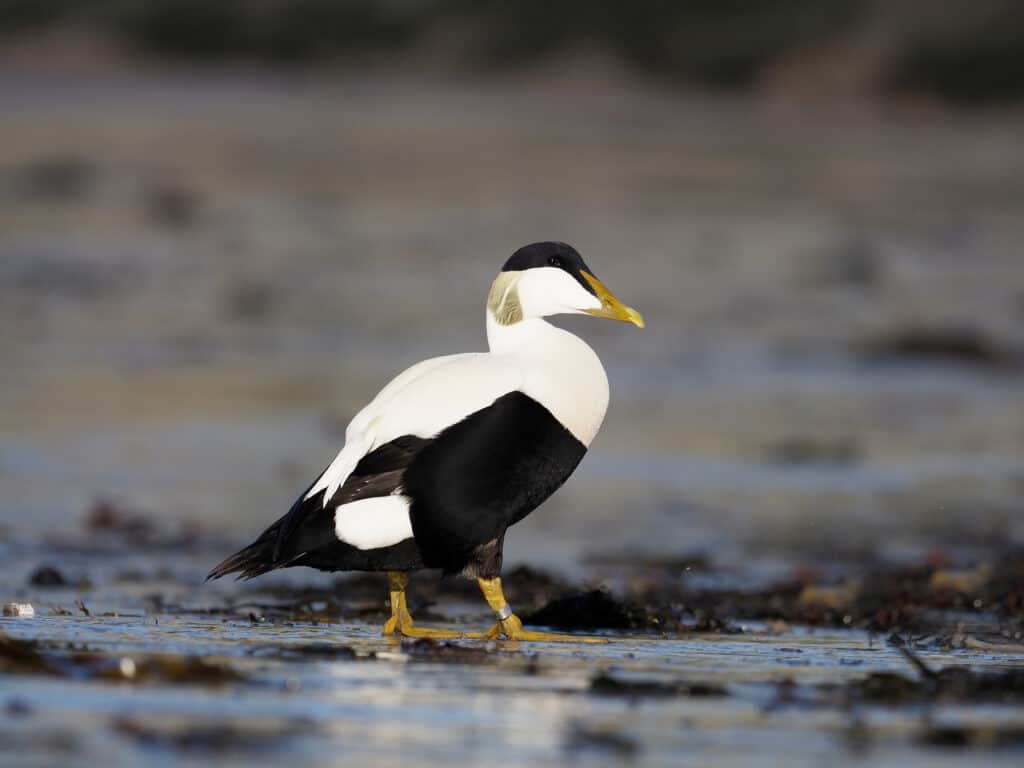Eider (original) (raw)
The eider (Somateria) is a genus of large seaducks in the cold northern hemisphere, inhabiting the Arctic tundra and Sub-Arctic coastlines. These swift fliers can reach exceptional speeds as they dive under the water’s surface, snatching mollusks and other marine animals and plants. Discover all the fascinating facts about eiders, including where they live, what they eat, and how they behave.
5 Amazing Eider Facts
- They use their famous eiderdown to form and line their nests.
- They can fly up to 40 mph!
- Eiders are sexually dimorphic, with males being larger and more colorful.
- They can dive underwater as deep as 180 feet but prefer to forage in shallower waters.
- Two of three eider species are near threatened due to several threats, including habitat shifting from climate change.
Where to Find the Eider
Eiders live in North America, Europe, and Asia in over 30 countries, including Canada, the United States, Russia, Norway, and the United Kingdom. They breed along Arctic coastlines and winter in Sub-Arctic and temperate regions. King eiders live on Arctic tundra and marine areas, while common eiders inhabit low-lying coastal islands near rocky coasts. And spectacled eiders live in wet tundra habitats. Look for them near water as they dive for mollusks and other sea creatures.
Eider Nest
They nest on the ground with surrounding vegetation like moss, grass, and low shrubs. They either form a cup made of down or line a scrape with down and plant material.
Scientific Name
The eider (Somateria) belongs to the Anseriformes order in the Anatidae family, which encompasses water birds, such as ducks, geese, and swans. The Somateria genus comprises the eiders and is Ancient Greek for “body” and “wool,” referring to its eiderdown. There are three eider species: common, king, and spectacled eider.
Size, Appearance, & Behavior

Eiders are a genus of three separate ducks. This is the common eider. Others are king and spectacled eider.
©Erni/Shutterstock.com
Eiders are large seaducks, measuring 20 to 28 inches long and weighing one to six pounds, with a 31 to 42-inch wingspan. They are sexually dimorphic, with males slightly larger and more colorful. Their coloring varies by species. Common eider males are black and white with green napes, and females are brown. King eiders have black and white bodies with bluish-grey heads, yellow foreheads, and red bills.
Eiders are generally social birds, forming monogamous bonds during breeding and foraging, and migrating with large flocks. These ducks are swift, agile fliers, reaching up to 40 mph! They are also excellent swimmers and divers, spending their lives around coastlines. Males produce pleasant cooing calls, and females’ vocalizations are more quick-like. They can be rather noisy when flocked together.
Migration Patterns and Timing
Populations in southern regions are typically sedentary in their range, but those in northern areas may travel long distances to more temperate regions. They breed along Arctic coastlines and winters in Sub-Arctic marine areas.
Diet
Eiders are either carnivorous or omnivorous and feed alone or in flocks.
What Does the Eider Eat?
Their diet consists of mussels, clams, scallops, starfish, crabs, sea urchins, small plants, and insects. The king eider eats mollusks primarily, but females will consume plant matter and insects during nesting. They forage by diving underwater to catch marine animals, sometimes in deep water but typically in shallow areas. They feed alone or in large flocks, diving simultaneously.
Predators, Threats, and Conservation Status
The IUCN lists the king eider as LC or “least concern.” Due to its extensive range and large population, this species does not meet the “threatened” status thresholds. The spectacled and common eiders are listed as NT or “near threatened.” Both species have declining populations, and their most significant threats include shifting habitats from climate change, hunting, trapping, pollution, oil spills, and predation.
What Eats the Eider?
Eider predators include Arctic foxes, otters, gulls, ravens, crows, minks, and skuas. Their young are most at risk of predation, and parents will fiercely defend their nests. They are usually successful in running off avian predators, but mammalian intruders, especially Arctic foxes, pose a more dangerous threat.
Reproduction, Young, and Molting
Eiders don’t typically mate for life but may remain monogamous during one breeding season. And multiple males may court one female by producing low cooing calls and exaggerated movements. Females lay two to seven eggs and incubate them for 22 to 24 days. The young can fledge the nest shortly after hatching (common eiders), but some, like the spectacled eider, may leave around seven weeks. Eiders become sexually mature around two years and can live an average of nine years.
Population
The global eider population is unknown, but the spectacled eider alone accounts for 250,000 mature individuals. However, all three eider species are declining moderately rapidly in their ranges.
Sources:
- https://www.iucnredlist.org/species/22680405/132525971
- https://www.iucnredlist.org/species/22680409/132526730
- https://www.iucnredlist.org/species/22680412/180227232
- https://deltawaterfowl.org/helping-eiders/
View all 148 animals that start with E
Eiders live in North America, Europe, and Asia in over 30 countries. King eiders live on Arctic tundra and marine areas, while common eiders inhabit low-lying coastal islands near rocky coasts. And spectacled eiders live in wet tundra habitats.
Eiders are large seaducks, measuring 20 to 28 inches long and weighing one to six pounds, with a 31 to 42-inch wingspan.
Males produce pleasant cooing calls, and females’ vocalizations are more quick-like.
Their diet consists of mussels, clams, scallops, starfish, crabs, sea urchins, small plants, and insects.
Their most significant threats include shifting habitats from climate change, hunting, trapping, pollution, oil spills, and predation.
Eider predators include Arctic foxes, otters, gulls, ravens, crows, minks, and skuas.
Females lay two to seven eggs and incubate them for 22 to 24 days.